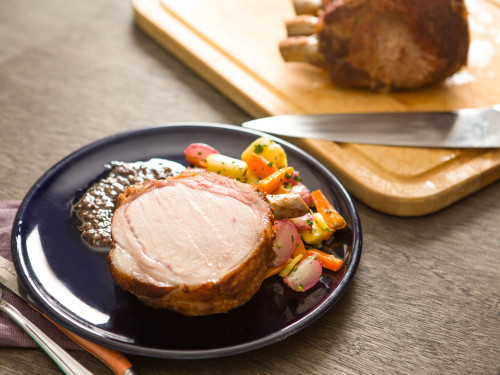
A pork loin roast is perfect for entertaining. [Photographs: Vicky Wasik]
Let’s take a moment to appreciate the triple threats of the world. In entertainment, there was Michael Jackson. Not only could the King of Pop sing and dance better than the rest, but he made sure to let the world know that he had acting chops, too. I mean, just look at his turn as the Scarecrow in 1978’s Motown classic, The Wiz. Watch out, DeNiro! (Seriously, though, I love that movie.)
On the plate, I’d have to give the triple-threat crown to a bone-in pork loin roast. In a Venn diagram of foods that are easy, impressive, and affordable, it’s one of the few cuts of meat that can fit right in that little area where all three circles overlap.
Sometimes called a rack of pork, the pork loin roast is nothing other than the cut from which pork chops are sliced.

[Illustration: Daniel Gritzer]
It’s the anatomical equivalent of a beef prime rib roast and a rack of lamb, but, unlike beef and lamb, pork tends to be relatively cheap pound for pound. As a table centerpiece, the full roast is just as regal as the others, making it perfect for entertaining.

The easiest, most reliable method for cooking it is the one we use for so many other cuts of meat: the reverse sear. It works magic on prime rib and beef tenderloin, and it works just as well for pork. To do it, we start by placing the roast in a 250°F oven to slowly cook until the center of the meat registers 140°F on an instant-read thermometer.
Why so low? Because that allows us to cook it all the way through to the center without overcooking the outer layers of meat, which is otherwise a big risk when you’re making large roasts. This way, we get the most even results, perfectly juicy with just a blush of pink from edge to edge. It takes about two hours to get there, though it’s always a good idea to start checking early, just in case yours is progressing faster than that. (Make sure to use a good thermometer!)
To finish it off, just take the roast out to rest until you’re ready to eat (it can rest for anywhere between 15 and 45 minutes without losing quality) and crank the oven up to 500°F. Because the exterior of the roast will be nice and dry from its time in the low oven, it’ll develop a crackling brown crust in just about 10 minutes. Slide a sharp knife between the bones to separate it into individual chops for serving. (Just make sure your guests see the rack first, for maximum impressiveness.)
For the very simplest treatment, you can just season the pork all over with salt and pepper before cooking it, but be generous: It’s a big roast, and since you’re only salting the outside, you need to go heavy.

If you want to take it a step further, you can rub other flavorings onto the pork, like an oil-based herb purée or a dry spice rub. I used the latter in the first recipe attached here—it’s just a simple mix of smoked paprika, garlic powder, and brown sugar. Then I served the pork with roasted root vegetables and a sauce made from tapenade thinned with a little olive oil.

Now, please back away from my plate of food, before I triple-threaten you.
To find more techniques and recipes join us on facebook:













